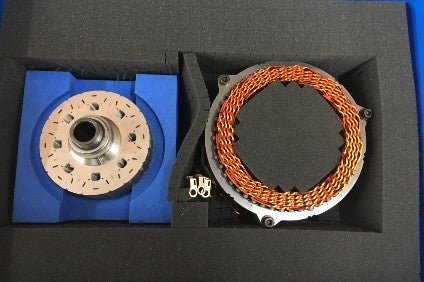
Toyota Motor Corporation (TMC) said it had developed the (claimed) world's first neodymium reduced, heat resistant magnet for electrified vehicle high output motors.
The invention requires "significantly less" of the rare earth element neodymium and can be used in high temperatures.

Discover B2B Marketing That Performs
Combine business intelligence and editorial excellence to reach engaged professionals across 36 leading media platforms.
The magnet does not require terbium or dysprosium which are rare earths also categorised as critical materials necessary for highly heat resistant neodymium magnets. TMC replaced a portion of the neodymium with lanthanum and cerium (Ce) which are low cost rare earths, thus reducing the amount of neodymium.
According to the automaker, neodymium plays an important role in maintaining high coercivity (the ability to maintain magnetisation) and heat resistance. Reducing the amount of neodymium and replacing it with lanthanum and cerium results in a decline in motor performance. New technology suppresses the deterioration of coercivity and heat resistance when neodymium is replaced with lanthanum and cerium, and delivers a magnet with equivalent levels of heat resistance as earlier neodymium magnets while reducing the amount of neodymium used by up to 50%.
This new type of magnet is expected to be useful in expanding use of motors in various areas such as vehicles and robotics, as well as maintaining a balance between the supply and demand of rare earth resources.
"Toyota will work to further enhance performance and evaluate application in products while accelerating the development of mass production technologies, with the aim of achieving early adoption in motors used for various applications, including in automobiles and robotics," the automaker said.
It added that development of elemental technology for motors, inverters, batteries, and other components "will require steady research and development in anticipation of the future".
"Toyota positions these technologies as essential for electrified vehicles and will continue making steady progress in each and every area, while working to build the foundation that will support the increased use of electrified vehicles in the future."
Approximately 30% of the elements used in magnets are rare earths.
When powerful neodymium magnets are used at high temperatures, such as for automotive applications, terbium and dysprosium are generally added to increase high-temperature coercivity. However, terbium and dysprosium are rare and expensive metals found in locations with high geopolitical risks. Because of this, considerable efforts have been made to develop magnets that do not use these metals, and positive results have been achieved.
Production volumes of neodymium are relatively high among rare earths but there are concerns shortages will develop as electrified vehicles become increasingly popular. Despite this, little effort has been made to address neodymium use, TMC said.
Planned use
The newly developed Nd-reduced, heat-resistant magnet is able to maintain coercivity even at high temperatures because of the combination of grain refinement of magnet, two layer high performance grain surface and a specific alloying ratio of lanthanum and cerium.
TMC expects to use the new magnets electric power steering motors for vehicles and other applications in the first half of the next decade.
It will continue development with the aim of practical application in high performance electrified vehicle drive motors within the next decade.






